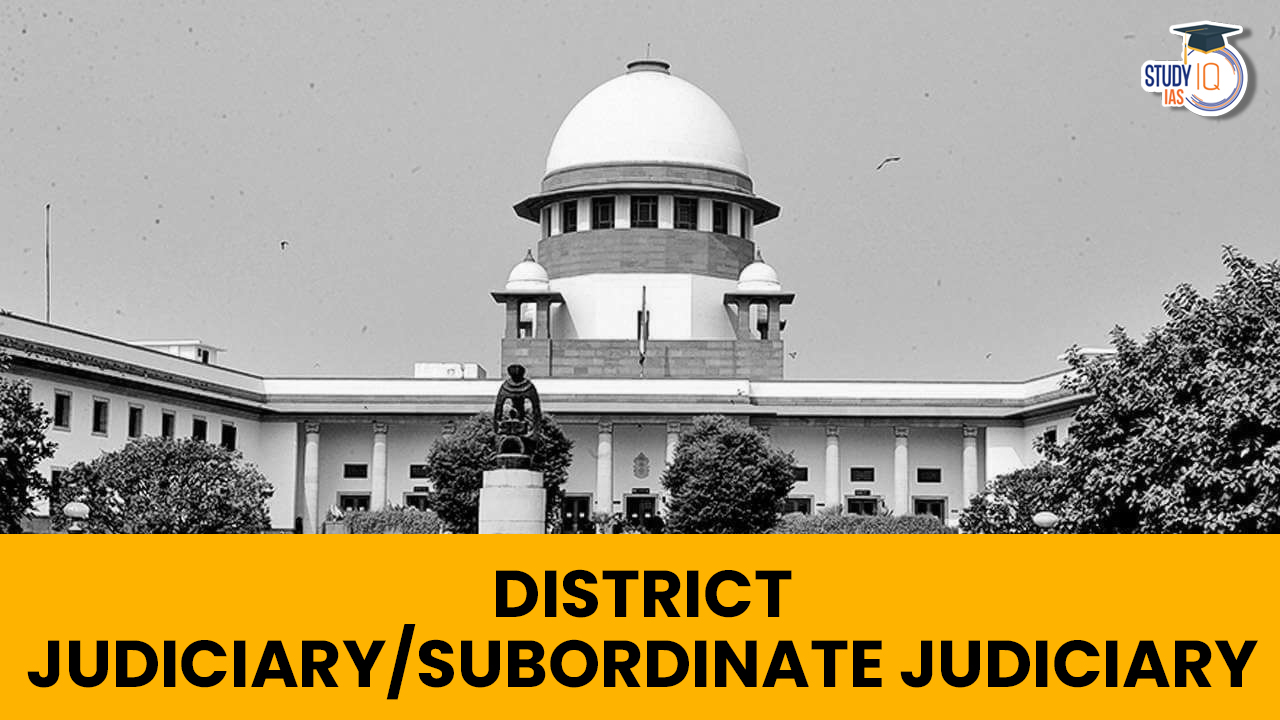Table of Contents
Context: The Supreme Court has held that the independence of district judiciary is part of the basic structure of the Constitution.
Background
- The Supreme Court has pronounced its judgement in the All-India Judges Association v. Union of India case.
- The case was pertaining to pay hike of judicial officers as per the recommendations of the Second National Judicial Pay Commission (SNJPC).
- Through its judgement, the SC examined and accepted various recommendations of the SNJPC on pay, pension and highlighted certain principles concerning judiciary.
- The SC ordered enhanced salary and pension for the judicial officers and underlined that the independence of the judiciary requires that pay of judicial officers must be stand-alone and not compared to that of staff of the political executive or the legislature.
- SC also ruled that the district judiciary should not be referred to as “subordinate judiciary”. It is a misnomer because the district judge is not subordinate to any other person in the exercise of her/his jurisdiction.
- The term Subordinate Judiciary is also disrespectful to the constitutional position of a district judge.
Judiciary in India
- Judiciary is an important organ of the government which acts as an arbitrator in disputes and also performs certain important political functions.
- The Constitution of India provides for a single integrated judicial system.
- The structure of the judiciary in India is pyramidal with the Supreme Court at the top, High Courts below them and district and subordinate courts at the lowest level.
- The lower courts function under the direct superintendence of the higher courts.

What are District Courts?
- District Court: The State is divided into districts and each district has a district court which has an appellant jurisdiction in the district.
- Function: The principal function of the District Court is to hear appeals from the subordinate courts. Subordinate courts which are the first port-of-call for most legal disputes.
- Constitutional Provisions: Articles 233 to 237 in Part VI of the Indian Constitution regulate the organization of subordinate courts and ensure their independence from the executive:
- Appointment of District judges: The appointments are made by the Governor in consultation with the high court.
- Qualification of District judges:
- He should not already be in the service of the central or the state government
- He should have been an advocate or a pleader for seven years
- He should be recommended by the High Court for appointment.
- Appointment of other judges: They are made by the governor after consultation with the state public service commission and the high court.
- Control over subordinate courts: The High Court exercises control over the District Courts and the courts subordinate to them, in matters as posting, promotions and granting of leave to all persons belonging to the State judicial service.
Structure of Lower Courts in Districts
- In each district of India there are various types of subordinate or lower courts. They are civil courts, criminal courts and revenue courts which hear civil cases, criminal cases and revenue cases, respectively.
- Civil Courts: Civil Courts deal with cases pertaining to disputes between two or more persons regarding property, divorce, contract, and breach of agreement or landlord – tenant disputes.
- The Court of the District Judge is the highest civil court in a district to deal with civil cases. The judge of this court is appointed by the Governor of the State.
- It is called the Court of District and Sessions Judge, when it deals with both civil and criminal cases at the district level.
- Appeals against the decisions of this court may be heard by the High Court of the State.
- Family courts, which are equal to courts of sub judge, exclusively hear cases of family disputes, like divorce, custody of children, etc.
- Munsifs and small causes courts decide cases involving petty amounts.
- No appeal can be made against the decisions of the small causes courts.
- The Court of the District Judge is the highest civil court in a district to deal with civil cases. The judge of this court is appointed by the Governor of the State.
- Criminal Courts: These Courts hear criminal cases which are related to violation of laws like theft, dacoity, rape, arson, pickpocketing, physical assault, murder etc.
- The Court of the Sessions Judge (known as Sessions Courts) is the highest court for criminal cases in a district.
- An accused can be awarded death sentence by the sessions court and can be hanged to death only after his sentence is confirmed by the High Court
- Below this court, there are courts of magistrates of First, Second and Third class.
- In metropolitan cities like Delhi, Calcutta, Mumbai and Chennai, First Class Magistrates are called Metropolitan Magistrates.
- All these criminal courts are competent to try the accused and to award punishment, as sanctioned by law, to those who are found guilty of violation of law.
- The Court of the Sessions Judge (known as Sessions Courts) is the highest court for criminal cases in a district.
- Revenue Courts: Theses courts deal with cases of land revenue in the State.
- The highest revenue court in the district is the Board of Revenue.
- The Courts of Commissioners, Collectors, Tehsildars and Assistant Tehsildars are under it.
- The Board of Revenue hears the final appeals against all the lower revenue courts under it.
- The highest revenue court in the district is the Board of Revenue.

Importance of District Judiciary
- The district judiciary performs an important role in upholding the rule of law.
- The independence of the district judiciary is a part of the basic structure of the Constitution. Without impartial and independent judges in the district judiciary, ‘Justice’, would remain illusory.
- District judiciary is most accessible to the litigant and handles 1.13 million cases every day.
- During the period of the pandemic, the district judiciary was efficient and undertook its functions to ensure that justice is delivered in a timely manner.
Issues in Lower Courts
- Judicial Pendency: The number of cases pending in district and lower courts stands at a staggering 4.14 crore. Over 1.1 lakh cases have been pending for more than 30 years in district and lower courts.
- Maximum number of oldest pending cases in India is in Uttar Pradesh, West Bengal, Maharashtra and Bihar.
- Judicial Vacancies: There are over 5,000 vacancies in subordinate courts against the total sanctioned strength of 24,490 which dents speedy disposal of cases.
- Lack of Physical Infrastructure: Inadequate infrastructure has resulted in overburdened courts, which in turn has led to a massive backlog of cases.
- The lower courts do no have court halls, lawyers’ rooms, and residential units for judicial officers.
- According to data from the National Judicial Data Grid, there are only 20,143 court halls out of which 620 are rented.
- 68% of lower courts have no dedicated rooms for record-keeping, and nearly half of them do not have a library.
- Lack of Digital Infrastructure: Digital infrastructure helps litigants access their hearings and also ensures that relevant information about cases, and the judges presiding over them, is accessible to the public.
- According to the 2021 survey by the CJI office, only 38% of lower court complexes had video linkages with jails, and 14% had video linkages with medical officers.
- Only 27% of subordinate courts can place a computer with a video-conferencing facility at the judge’s dais.
- Lack of Funding: The Centrally Sponsored Scheme (CSS) for Development of Infrastructure Facilities for Districts and Subordinate Judiciary provides for financial assistance by the Centre to the States for the construction of court halls and residential units for judicial officers and judges of the district and subordinate courts.
- The funding plan uses a ratio of 60:40 between the Centre and the States.
- The allocation provided under CSS so far has been highly inadequate and disproportionate to the needs of the judiciary.
- Non-utilisation of Funds: Some States have failed to fulfill 40% criteria of CSS. As a result, the allocated funds either go unspent or they lapse. Certain States have diverted funds meant for judicial infrastructure to other projects.
- Stay Orders from Higher Courts: Delays in the lower courts are also caused by stay order issued by a high court or the district court itself which can temporarily stop a judicial proceeding and require responses from involved parties.
- Lack of Witness: Lower courts also struggle to secure the presence of witnesses which causes further delays. Around 17% of cases pending for more than 5 years are delayed because of the complexity of the case.
- Hamper Economic Growth: Land-related issues take significantly more time than the average case with nearly two-thirds of these cases resolved after three years. Such type of delays cast a ‘long shadow’ on economic activity. Slow courts with uncertainty do not allow firms to make crucial investment decisions.
Way Forward
- The 245th Law Commission suggested that the number of judges should be increased along with improving infrastructure in lower courts to address delays.
- There needs to be an increase in the staff strength of the lower courts.
- To improve this infrastructure, the 2018-19 Economic Survey recommended creating a specialized service called the Indian Courts and Tribunal Services (ICTS).
- It would provide critical administrative support to Indian judges.
- This would allow judges to devote time to judicial activity while the ICTS could focus on streamlining processes and reducing case-related delays.
- National Judicial Infrastructure Corporation (NJIC) can be created to address the infrastructure gaps in the system. NJIC can monitor and act on the perennial issues of delay in land allotment, funds diversion for non-judicial purposes.
- The Department of Justice (DoJ) can show the required leadership by increasing its interactions with state-level officers to ensure timely implementation of the central scheme.
- Timely updates for websites of subordinate courts should be mandated. This can ensure that transparent mechanisms are accessible to the public to check the status of infrastructure projects.
- Central scheme’s effectiveness can be strengthened by having timely performance audit of the utilization of funds meant for infrastructure projects.
- There should be a decline in adjournment culture. At the first hearing, the judge should ask counsel to give a date they agree on and should be made clear that no adjournments will be given.
- Efficient functioning necessarily requires judges of calibre and capacity to be provided with the right incentives and promotion opportunities to maintain the high level of functioning of the district judiciary.
- The district judiciary is the backbone of the judicial system. To secure their impartiality, it is important to ensure their financial security and economic independence.


 TALASH Initiative: Objective, Key Featur...
TALASH Initiative: Objective, Key Featur...
 Custodial Deaths in India, Types, Issues...
Custodial Deaths in India, Types, Issues...
 MPPSC FSO Recruitment Notification 2025 ...
MPPSC FSO Recruitment Notification 2025 ...





















